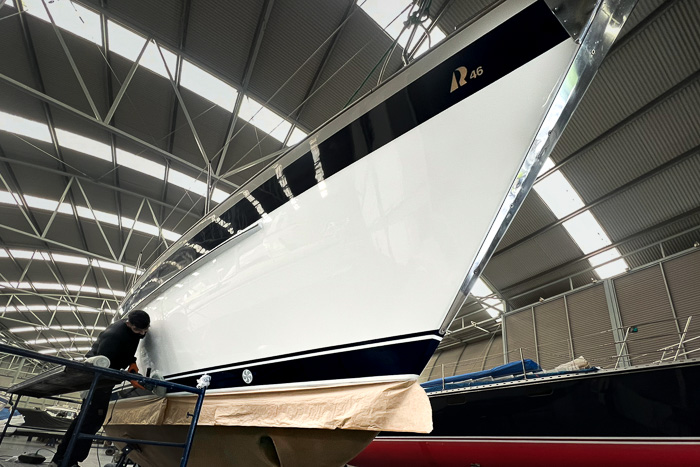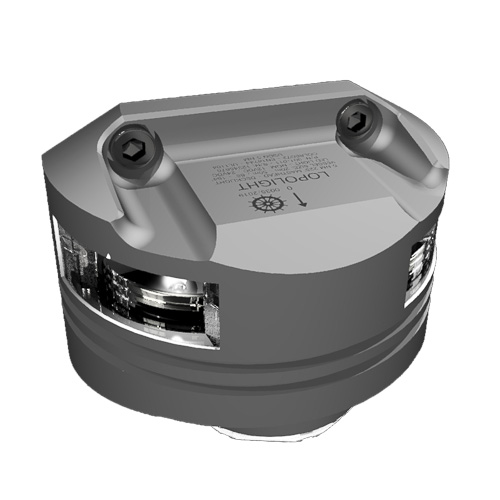Refit year 11
11th refit and 4th winter in Marina Coruña, Spain
To me, Regina Laska has finally become the perfect boat where it's beginning to become really hard to find further improvements. Therefore, the main emphasis is on keeping her in mint condition.
These is a sneak preview of what is currently being done to Regina Laska. More pictures and updates to be added next week, when I again re-united with Regina Laska for my eleventh sailing season with her.
Polished hull and repairing the mark in the stern
As in every year, Regina Laska's hull is being polished and waxed.
Also the dent that happened earlier last summer has been completely repaired with the transom receiving a new cover of spray-paint. Thank you, Robin for your excellent work!

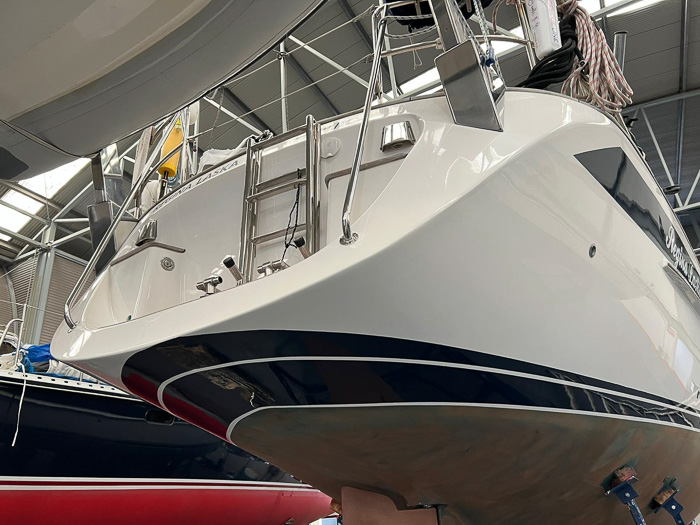
Remember the mark I did? See video here. It's now completely repaired!

The mark I did while backing into the pontoon last summer completely repaired.
Re-activating Coppercoat
The hull has been sanded to a minimum to re-activate the Coppercoat. It had lost is greenish tint during last summer and I had to dive several times to re-activate it under water by scrubbing the hull with a huge "Scotch-Brite".

This is what I brushed the hull with while diving last summer in order to re-activate the CopperCoat.

They continued my re-activation job by just very, very lightly sand the hull, so new, fresh copper is being seen at the surface. You can see the copper-colour that in the water should get green. If the CopperCoat is black, it doesn't work.
All winches serviced
As in each year, all winches are taken apart and looked at and necessary parts are being exchanged. The new or cleaned parts are being greased and put together for yet another sailing season.

Changing Cutlass bearing
Looking after your engine is as important as servicing your rig and making sure your through-hulls in good condition. It's vital och many things you can't judge from the outside. Make sure it's fixed before it breaks!
After 1,700 hours of motoring since new (2018), the cutlass bearing was changed after 5 years of intense use. The "Black Jack" shaft seal was also changed at the same time.
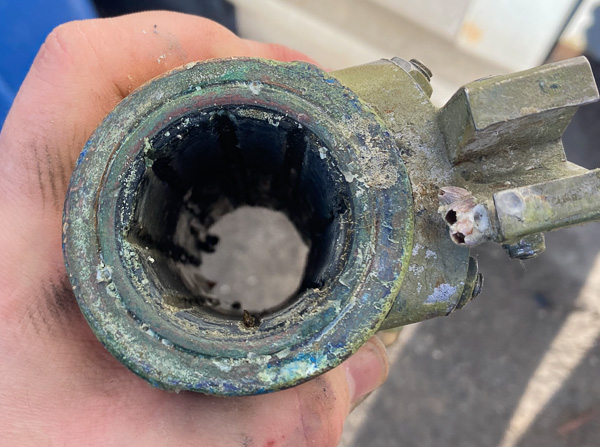
Time to change!

The shaft from the inside prepared to change the "Black Jack" shaft seal.

The old Cutlass bearing needed to be changed. This is the "hole" with the sealed bearing where the shaft is going through.
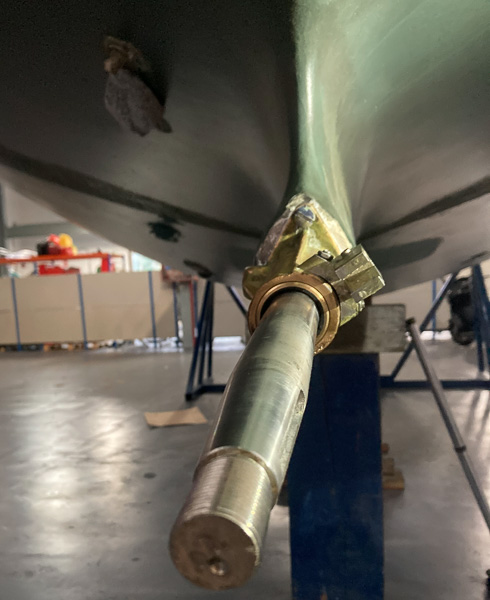

Cleaning the turbo
After 1,700 hours of motoring since new (2018), it was time to clean the turbo. Far too often one motors at too low rpm's. When doing so, the turbo gets carborated and needs to be cleaned regularly.

The turbo being cleaned
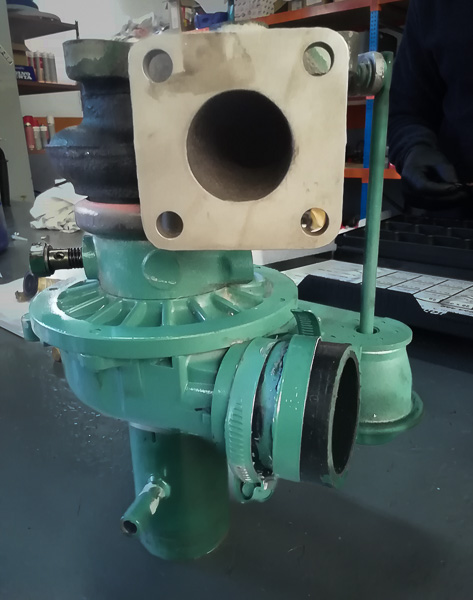
Elbow changed
After 1,700 hours of motoring since new (2018), it was time to clean change the elbow, where salty corrosive salt-water is mixed with the hot exhaust. You can clearly determine when it's time to change it, since cooling gets less efficient. Last autumn, when running on full throttle, the engine got quickly over 102°C hot and before it was overheating, I had to reduce the rpm. Normally, you don't notice since you seldom run on full rpm. Now, with the new elbow, it never went over 89.9°C even after 20 minutes of full throttle.
On the photos you can clearly see that it was time to change the elbow!



Time to change after 4 years and 1,700 hours.
Changing the Volvo Penta rubber cushions
After 1,700 hours of motoring since new (2018), the rubber cushions need to be changed. During the test sail I could feel some vibration in the pedestal I would like to get rid of.

Volvo Penta rubber cushions
Engine room temperature
I like having control. So one thing is to know the engine oil temperature, another thing what the engine room temperature is. This is good to know when, for instance, the fire alarm would go off. You could check if the engine room temperature is rising. Then you have a problem. Or, when the air gets too warm, I can switch on the external engine room fan.
Anyway, another nice input good to know!

Engine (oil) temperature is 83.9°C and the engine room temperature is 39.1°C. Engine is spinning along at 1960 rpm (the turbo is just beginning to turn) and the True Wind Speed (TWS) is 8.6 knots. The Apparent wind speed is shown on the sailing instrument to the right, here it's just nice to know what the true wind speed is in case it's time to switch off the engine and start motoring.
Prop-Speed re-done
After two great seasons with Prop-Speed the propeller was cleaned again and a new coat of Prop-Speed was added for the coming two years.
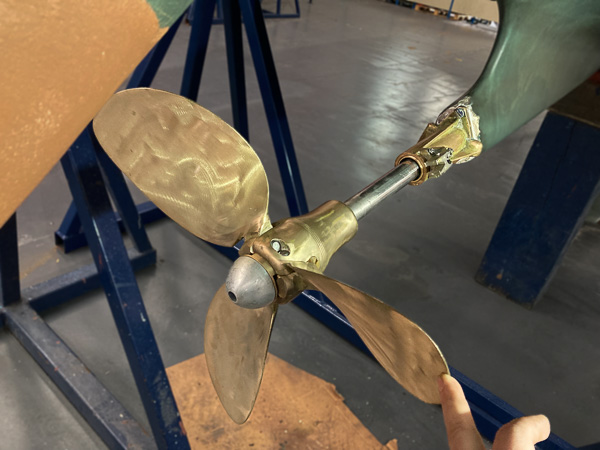
The cleaned propeller

The new coat of Prop-Speed to avoid growth and fouling on the propeller. It's a great product!
Checking Diesel Quality
This is part of a standard procedure and is being done each time the boat has been filled with fresh diesel. After a night of very few movements of the boat (no rocking!), the diesel is pumped out from the lowest point of the diesel tank. The sample is held against the sun and it's checked if there is water in the diesel or other debris. If it is: continue to pump until only clear diesel is pumped. And if you still don't pump clear diesel or if it is regularly looking bad, it's time to empty the diesel tank and clean. This was done some years ago and the diesel looks perfect!
To avoid condensation water in the diesel, have the diesel tank filled before laying up and check in the spring.

The diesel pump in the engine room. From here diesel is manually pumped up from the lowest point of the tank. If you don't have that pump, I recommend installing it.
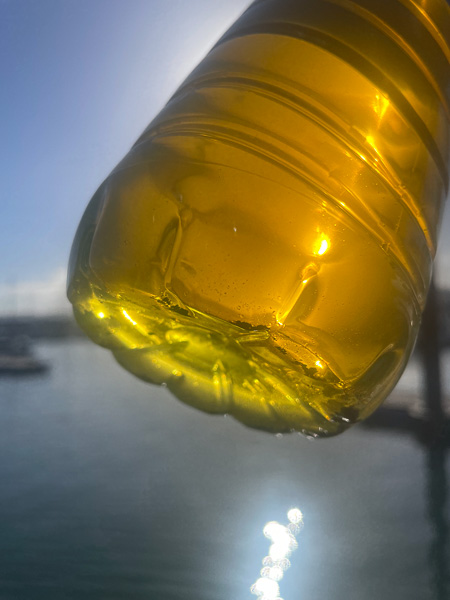
All nice and clear diesel with no water in the bottom.
New semi-fixed Bimini
The desire is the have a rigid Bimini that still easily can fold down and being stowed away in front of the hardtop if not needed.
Marina Coruña got the request to design and build a new Bimini, but we have to wait and see what they will have come up with. The current Bimini is held in place by thin ribbons, which gives a rather flexible construction.

The old construction: Bimini held in place with four ribbons. We will see what Marina Coruña can come up with...
The new rod-based replacement of the ribbon is placed out of the way of the main sheet. With the ribbon knotted onto the aft coachroof handrails, the lee ribbon always had to be loose during downwind sailing. Since the rods are placed forward of the main sheet traveller, you can freely sail ddownwind.
The fittings are made in such a way, that it's a matter of seconds that you disconnect the rods and store them away (in the aft deck locker for instance). You can thus fold the bimini forward like before and easily take off the canvas if desired.
This should become standard on HR's biminis if you ask me! Such a great solution!


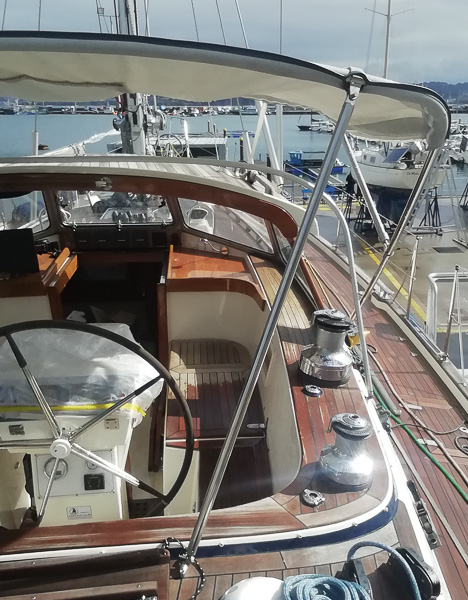
dav

dav

sdr
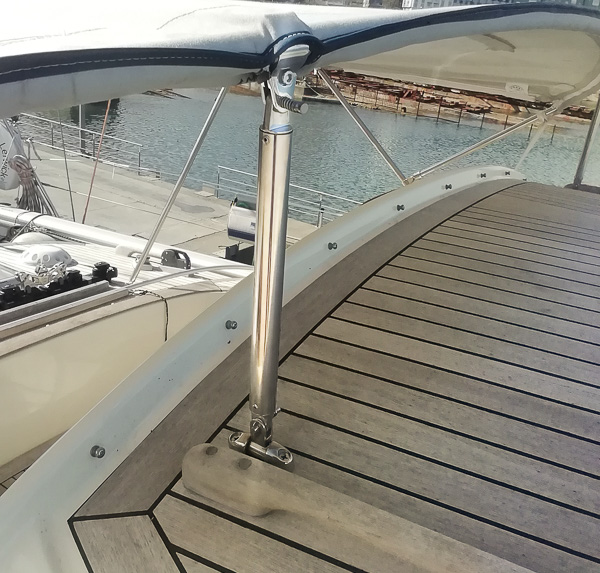
New main sheet traveller
The main sheet traveller has been upgraded to a Seldén traveller.

New anchor buttons
After 10 years, it's time to change the electric buttons for the windlass. They had only semi-covers, meaning that the central part of the rubber was exposed to the UV-rays. Having said that, the electrical buttons by MZ Electronics are so simple that I can't see how it would give a positive contact even when soaked. This is really what one fears: that an electrical contact is closed letting the anchor windlass work un-intendedly. The MZ Buttons are of such a design, that possibly they might not give a contact if broken, but never let the windlass spin without intention.
I therefore replaced with identical buttons, this time, however, fully covered, which protects against the sun as well as feet, which might step onto the buttons...


Strengthening anchor lock and adding micro-cleats
The anchor brake needed som extra re-enforcement from under deck and got some welcoming "micro-cleats" to tie the bolt to, so one doesn't lose it overboard in heavy seas.

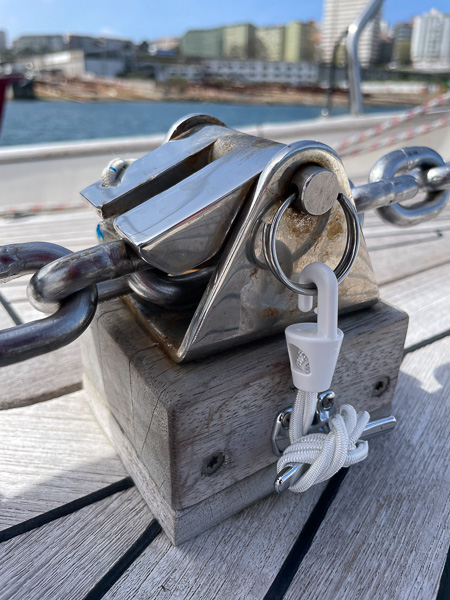

Changing freezer compressor
Back in 2015, Regina Laska was refitted with completely new fridge and freezer. The fridge compressor and the evaporator for the freezer were later replaced in 2022 (they didn't have more parts). In 2023, the rest is now also being changed, so we will have new fridges and freezers. After 7-8 years, it feels timely to change since they run 24/7 for 6 months per year.

Isolating freezer pipe: but not all types!
I thought I had done a good thing to isolate my freezer pipe with insulation, see photo.

However, I later learnt that you should not isolate aluminum pipes (these are white) since if water is trapped behind, it could mean corrosion. Isolating copper pipes is no problem, however. Unfortunately, the work I had done had to be removed again, since behind my nice isolation there was an aluminum pipe.
Not all refits are successful and need to be reverted in the end, not to make things worse, like here: risking corrosion of the aluminium pipes (don't ask me why some pipes are made out of aluminium and some out of copper... maybe just to make life onboard more complex?).
New deck wash pump and refurbished strainer
After 10 years it happened: A misunderstanding in the communication from fore-deck to the navigation station down below while lifting the anchor. The crew under deck switched on the pressure pump to clean the anchor, while it was never necessary on deck and unfortunately soon forgotten that it was still left switched on. The engine noise overturned the sound from the pump and so it was running (dry) for hours and broke. Lesson learnt and time to change.

The refurbished strainer for the deck-wash pump made out of bronze.
From 2023 onwards, the deckwash pump will be integrated to the new Czone control system (see below) it it can be switched on and off remotely from the pedestal. This was also a request by the MCA inspector, by the way, namely that the deck-wash pump should be switched on from deck since it double-acts as a fire pump as well.
Changing pneumatic arms
The arms holding up the deck lockers are being replaced with a more beautifully designed deck fitting and for the sake that the old ones were getting close to 10 years old.

dav

New arm for forepeak hatch
The hatch in the fore-peak has received a new arm that an hold the hatch open at a desired angle. Before it was only held by friction, which was not ideal considering the size and weight of the hatch.

New Main Sheet traveller
The old Lewmar main sheet traveller will be upgraded to a strong Seldén traveller. The blocks have already been replaced by Seldén a couple of years earlier.
Picture to follow.
New Preventer System
In order to quicker install a preventer and to avoid the necessity to walk all the way to the boat in order to rig it, a new preventer system will be installed, idea with thanks from Gerret & Katrin from Australian HR53 Balena.
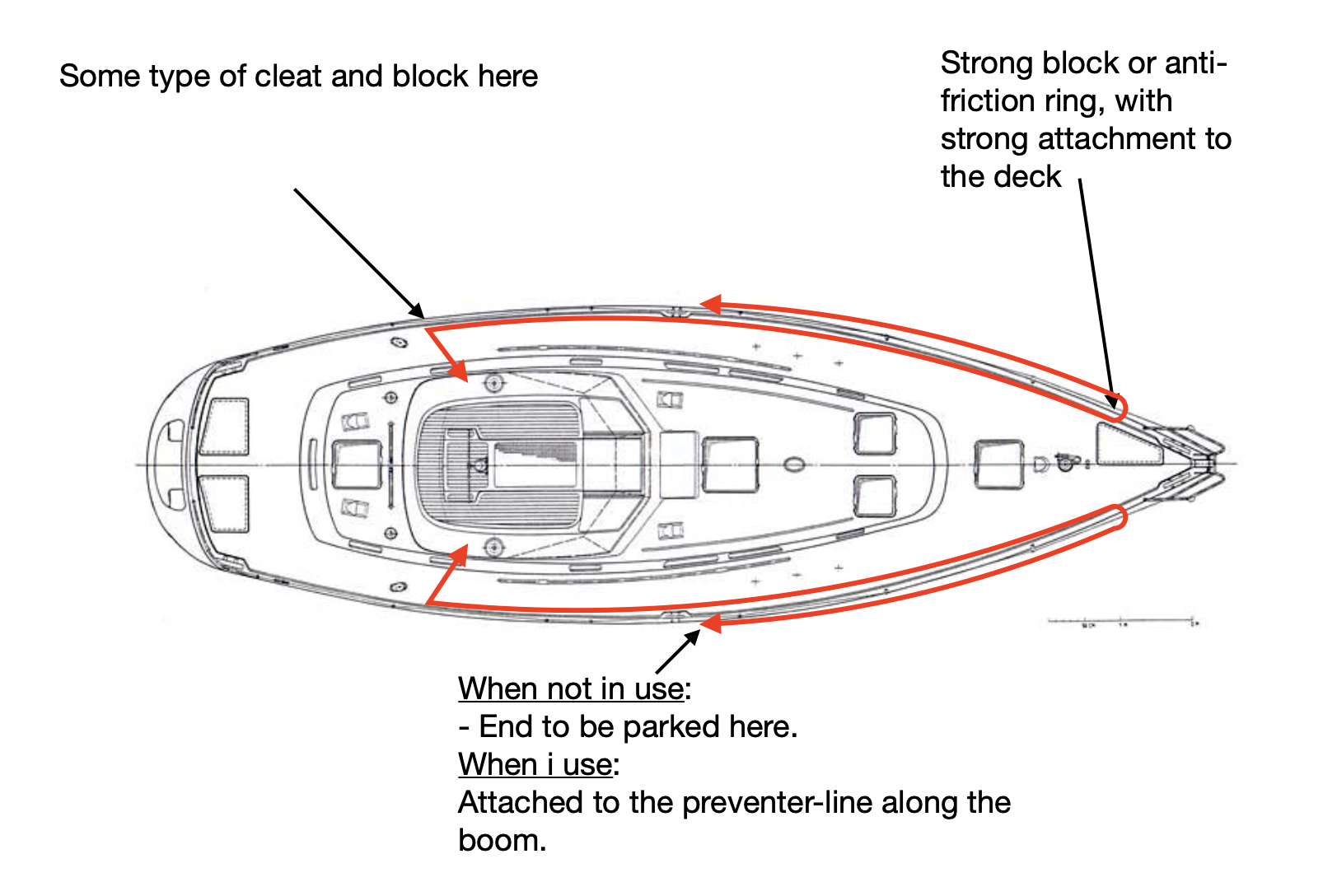

Forward most part of the port preventer with an anti-friction ring.

Two stanchions further aft: the forward lead is going through the ring, the part intended to be connected with the preventer stored on the boom inside the shackle, ready to be lifted up when used. Note that on the HR46, the preventer leading to the boom is running on the INSIDE of the life-line, which might come as a surprise. But this is how it is best lead to avoid chafing. Also, when sailing on a broad reach in heavy swell, the preventer can be used when lead this way. You have to test how it is best lead on your boat.

Stanchion by the mast. The part of the preventer to be connected with line parked on the boom is fixed by means of a bowline.

Preventer on the stanchion close to the cockpit. Without having to leave the cockpit, you can lean out and trim the preventer. Despite being from Seldén, I don't trust these cleats completely, so whenever possible, I will secure the preventer on one of the smaller winches. I plan to use this cleat only when I need the smaller winch for trimming the main sheet (starboard) trying to avoid a jibe at all cost while only hanging on this cleat. The port winch is mainly free anyway and only used for the port running backstay, which I don't use on the same side as the preventer, anway (leeward side).
I know of a HR53 who actually fully relies on the cleat for his preventer. The biggest force occurs when the boom gets some movement and needs to be stopped by the preventer (F = m * a, remember from physics…?!). So if the acceleration (a) is zero, also the force is zero.

This is the second part of the preventer stored along the boom. The eye is spliced so it's easy to connect with the line along the stanchions. There is another identical preventer system on the starboard side.
To avoid slamming of the preventers parked on the boom, there are smart clips that can be ordered from a sailing colleague of mine, who 3-D prints them for other sailors. You can buy them here.
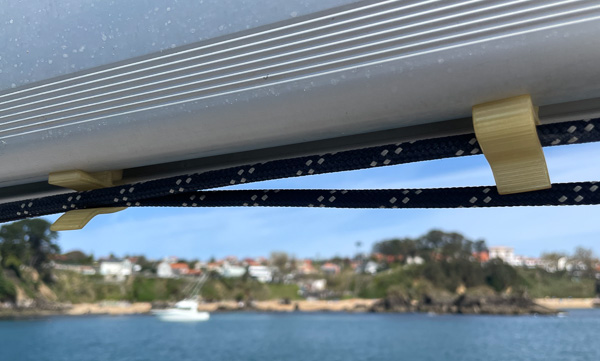
The Boom Preventer Clips avoid slamming of the preventer against the boom.
Cable ties along shackles
Nothing new, but worth reminding, since I very often hear from headsails coming down with the halyard still on the mast top! Don't forget to make sure the shackles don't open accidentally!

Chafing...
The never ending search for avoiding chafing leads to place adequate covers wherever necessary. Some new places were found where lines might chafe, here the vang that was lead down into the cockpit during last year's refit.

Rebuilding the emergency bilge pump
The 10 year old Jabsco Warrior manual bilge pump is the last resort to keep water on the outside of the hull. It's one of these vital safety pieces that you have and forget, but are you sure they work as efficiently?
After 10 years of just sitting there, it was dissembled and rebuilt. All rubber seals have been changed and the painted aluminum re-done, since it began to corrode from the inside. Corroded aluminium is not 100% air tight so creating a vacuum to pump up water from the deep bilge to the pump is not guaranteed. Better to rebuild it every 10 years!


New bilge alarm and bilge pump automation
While testing the rebuilt manual bilge pump we filled the bilge with fresh water and noticed that the bilge pump automation did not work reliably. Therefore we decided to change both the automation (lower float switch) and alarm (upper float switch), although only the lower one was malfunctioning due to dirty bilge water.
Another of these safety things that need to be tested regularly.

The 2 new WEMA float switches on their way back down into the lowest part of the bilge. The lower one triggers one of the 4 electric bilge pumps (the small Whale Gusher membrane pump). The upper one is giving the bilge alarm, in case the pump is not working or the water ingress is bigger than the pump can cope with. The best way to check is a visual check, of course, which should be done daily.
New engine room fire extinguisher
The 10 year old 10L CO2 fire extinguisher for the engine room has been replaced by an approved automatic SeaFire NFD300 extinguisher in the engine room. Its pre-engineered and doesn't need any manual operation.

Refurbishing the cockpit locker
The old 10L CO2 fire extinguisher has been removed from the cockpit locker. This was a perfect opportunity to refurbish the cockpit locker. It's now nicely repainted and has much more space for storage.

Freshly painted and good storage capacity. Have you looked at the modern designs of sailing boats? Have you checked the cockpit locker? Classic designs had a good emphasis on storage!

Sealed gas compartment
Rusty Camping-Gaz bottles that are not being accepted after just a couple of weeks in the gas locker has been extremely annoying throughout the years.

This is how a Camping-Gaz bottle typically looks after a couple of weeks in a hot, salty environment with breaking seas. Bottles made out of aluminium or composite are much better, but unfortunately there is no international standard except the wide-spread, inferior Camping-Gaz.
The lid has now been sealed properly and it will be held in place by means of a Roca lock: the more you turn, the tighter it gets.




Marpol bucket
To avoid oil-spill following the Marpol Regulations, I now have a small bucket (ex greek yoghourt) with good-to-have stuff when bunkering diesel. The wooden plugs, for instance, are to be placed into the deck drain to avoid diesel spill into the sea. The oil-soaking cloth is there to clean up any oil spill and the gloves give protection when adding biocide to the diesel to avoid growth in the diesel tank.

Refitting the companionway beam
Someone (no names...) made some pull-ups hanging on the companionway beam. I never told him that his overdoses of adrenaline resulted in a loose beam. Shit happens, and most things can be repaired, also this beam!

New silicone and refurbishing the fridge
After some years, it's just time to reseal the worktop in the galley and to replace all silicone. Especially the opening of the fridge needed som love and care.

Note the black discolouring above between the worktop and the tiles in the background (black stains). Time to change the silicone!


New Melamine Plates
We use Hallberg-Rassy china produced by Swedish renown Rörstrand when in harbour and enjoy a glass of wine using Regina Laska's Riedel glasses. But under way, we have so far used normal cheap plastic bowels. These under-way, making-way bowls and small plate are now being replaced by Melamine wear by Italian ATEP.

All external buttons on the pedestal replaced
After 10 years, it just feels good to replace all buttons on the pedestal which are constantly exposed to UV-light and water. They did still work all right, but better safe than sorry and I like to change before things break.

Varnishing the pedestal
While working on the pedestal, the teak on top gets re-varnished.

New Poldina Lamp
For cozy nights outside, there is a new Poldina Mini light with cozy 2400K temperature, dimmable and with a heavy foot. It's USB charged.
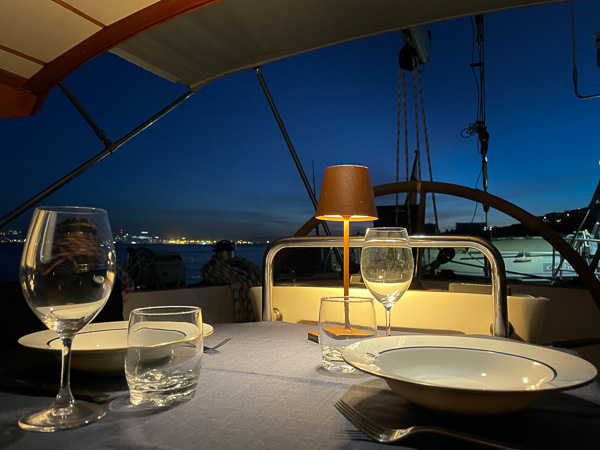
8 new Boatsystem Reading Lights with USB
Regina Laska is replacing it's current Båtsystem D2 USB to the new LEIA SX1 with a flexible arm for easier reading, built-in dimmer and 2A USB-charger. They will be placed at all berths. The lights in the Salon remain unchanged and have already been upgraded to Leia some years earlier.

Replacing the LED-Tape by Boatsystem
The old 600-Tape for indirect lighting has been serving well during the last 10 years and were still going strong! Not a single LED diod broken after 10 years and 6 months per year of usage (almost 24/7). Of course, it's a lot thanks to the voltage regulators I have built in.
Still, I chose to replace it by new for another 10 years of great lighting.


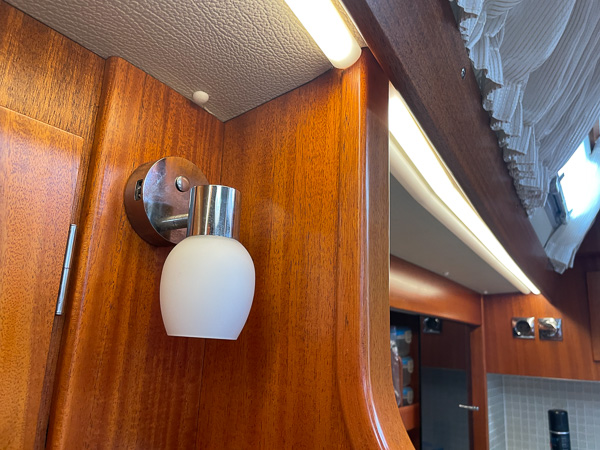
Maintenance sometimes means changing to the same with no direct visible change. Just prolonging the life-span.
Checking the genoa sheet travellers
While the ceiling was down, it was a perfect timing to check the bolts for the genoa sheet travellers, which had begun to give a certain squeeky sound when sailing hard upwind with extreme load. And yes, you could actually turn the bolts a turn or two, so it was great to tighten the bolts!

Servicing the genoa sheet travellers
Being still strong, the genoa sheet travellers all got new sheaves and a new trimming line.

Rig check
Despite the fact that the rig was completely changed 2022, I needed a rig-check for my 5-year out-of-the-water inspection. Luckily so, since Chuny and Matias from Marina Coruna actually found one very small crack on a new D2. Most probably this is due a manufacturing problem in the wire factory. I therefore changed all wires (again) that were from that production slot, i.e. all 10mm wires. Luckily, only the D2's are made of 10mm so I only had to change these.

Hardly visible to your eye, but they found it! Not acceptable so, both D2's were changed to be on the safe side.
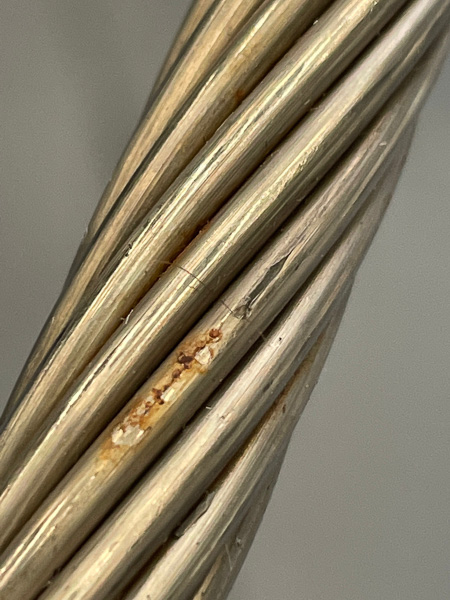

New Wind Scoop
For the warm days, Regina Laska will offer three new Wind Scoops called "Cabin Breeze" by Waterline Design (Boatsystem Group). These are considerably better than the conventional type that needs to be tied to the hatch. This one fits under the hatch by means of a smart springloaded ring. It even has built in mosquito nets!

Key to open toilet lock
If someone gets stuck in the head and cannot return or gets sick inside, there is now a key to open the head from the outside.
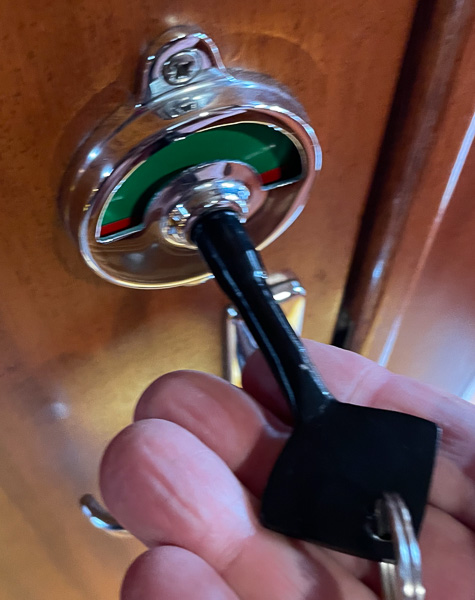
New Log Impeller
After over 35,000 miles of constant turning, it's time to retire my little paddle wheel. It will be replaced by the next generation Airmar DST810 with the new, more modern paddle wheel design.

A great feature is that you only have to calibrate it once at the source by means of bluetooth and your smartphone. With my current log, I had to change the setting in every display individually, since the log was only supplying raw-data. Having your log calibrated to the 1/10 of a know is important for tidal navigation and gives a great satisfaction when you can see accurate Speed Through Water comparing it to Speed over Ground (SOG derived from your GPS) that your tidal calculations were correct.
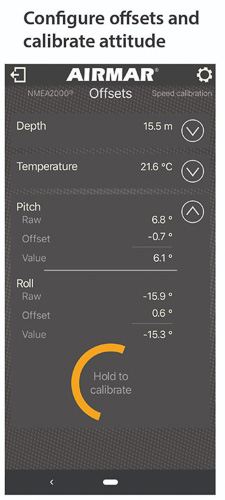

I have also been thinking of the electronic Airmar DX900 but I have heard that it is not so easy to have an ultrasound depth sounder so close to an electronic speed log. The electronic speed log makes sense, if you have a separate hole for the echo sounder, but I want two independent sounders, and one of them should be in the built in tri-data-sensor. Hense, the DST810.
All Cables New in Mast
All cables inside the mast are being replaced. Most of them after 10 years. Cables corrode and especially for radio signals, it is vital that enough power is being sent to the top of the mast with minimal loss. That's also why Regina Laska has separate antennas, e.g. for AIS and VHR, since they operate on different frequencies (AIS on 161.975 MHz, VHF Ch 16 on 156.8 MHz). yes, they are similar, but still different and should therefore ideally have two antennas with different length, in addition to a Coax-cable with minimal loss and no corrosion.
In addition, all other cables for horn, decklight and navlights will be replaced, also because all these nav- and deck-lights will be replaced.

There are very many cables going up the mast...

Beautiful new cable covers at the foot of the mast.
All Navlights and Decklights replaced by Lopolight
Regina Laska is updated with the superior Lights by Lopolight, manufactured in Denmark. Both decklights and Navlights will be replaced. And yes, finally I can show Red-over-Green on the mast for a proper sailing vessel. The lights in questions are:
| Lopolight | Function |
|
201-005W+012+014G2-B |
|
|
200-016G2+018G2 6M |
|
|
301-011DLX 15M |
|
|
400-222 |
|
|
301-001 |
|
|
301-002 |
|
|
301-006DLX |
|
|
400-082-26 |
|

Sternlight with the combined bathing platform deck light, installed by Raul from Nauelec.

The new port light installed by Raul.

Nice red deck light for keeping a good night vision.

Great nice white working light on deck thanks to one light pointing forward plus two on each spreader.
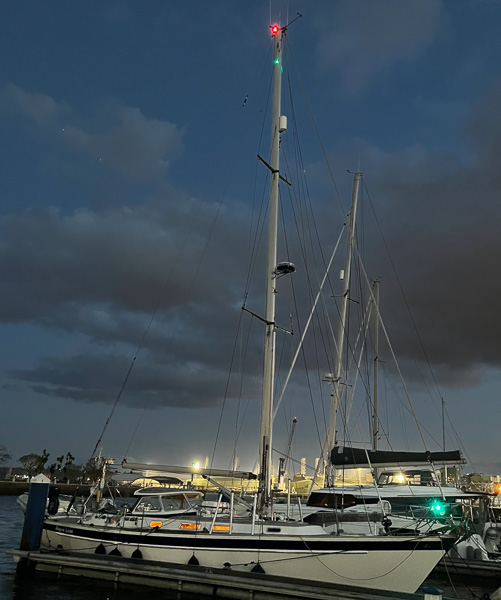
Proper sailing nav-lights: omnidirectional red over green on the mast top plus nav-llights at deck level.

New Czone Control
NewZealand based Czone makes very robust control systems for any type of electric systems. This flexible system grows with demand and as a first step Regina Laska will get 3 connection boxes with 6 channels each for controlling navigation ligths, deck-lights and the deckwash/fire pump.
It's all being installed by Nauelec in La Coruña in co-operation with Marina Coruña. Czone is supplied by Gotthardt in Germany, who give an excellent service.

Czone Contact 6 PLUS with manual override function.

The Czone Contact 6 PLUS can be controlled by the MFD (Plotter, e.g. by Furuno), but I wish to control the light also without the plotter. Hence 2 x 6 buttons. One vertical for the navstation and one horizontal for the pedestal.
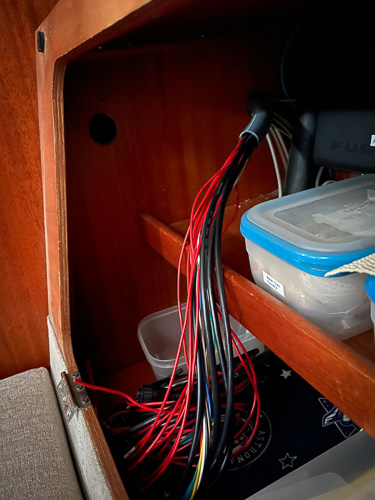
All prepared to be connected with the three Contact 6 PLUS.

The new Czone light buttons on the pedestal.

Czone buttons at night
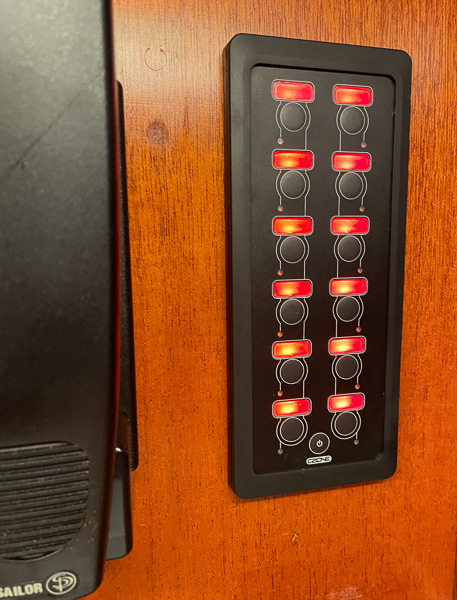
The three Contact 6PLUS have the big advantage that you can override the bus-system in case it malfunctions. Deep in my heart, I never fully trust bus-systems, and therefore I very much like this feature with the PLUS-units.

| Contact / Button | 1 | 2 | 3 | 4 | 5 | 6 | 7 | 8 | 9 | 10 | 11 | 12 |
|---|---|---|---|---|---|---|---|---|---|---|---|---|
|
| Sailing | Tri-Col | Motor | Strobe | Com-pass | Anchor | NuC | Deck Red | Deck Fwd | Deck Aft | Deck Stern | Deck Pump |
| Windex | x | x | x | |||||||||
| Tri-Colour | x | |||||||||||
| Anchor | x | |||||||||||
| Red 360° | x | x | ||||||||||
| Strobe | x | |||||||||||
| Lower red 360° | x | |||||||||||
| Lower green 360° | x | |||||||||||
| Steaming | x | |||||||||||
| Decklight front & Decklight spreader white | x | |||||||||||
| Decklight spreader red | x | |||||||||||
| Navlight stern & Navlight port & Navlight starboard | x | x | ||||||||||
| Compass light | x | |||||||||||
| Bathing Platform light | x | |||||||||||
| Deck Light Aft | x | |||||||||||
| Steplights & Underwater light | x | |||||||||||
| Deckwash / Fire pump | x | |||||||||||
| Free | ||||||||||||
| Free |
New Filter System
The water in the tanks should hold chlorine to ensure an antibacterial environment in the tanks. As a last step, just before the water is lead through the outlets, is may go though either a 20 Micron filter with active coal or, at the galley sink in an extra outlet, a sub-Micron filter, e.g. the Seagull IV filter.
This has been installed since long, but any water led from ashore has been entering the boat completely unfiltered, meaning that also small debris is filling the tanks, and blocking up the filters.
Using some standard hoses and some quick connectors from Gardena, I will build a simple filter system using either a washable and thus reusable 150 Micron or a 60 Micron filter. Also added is a flow-meter to keep track on how much water I'm filling up.
We will see how it works...
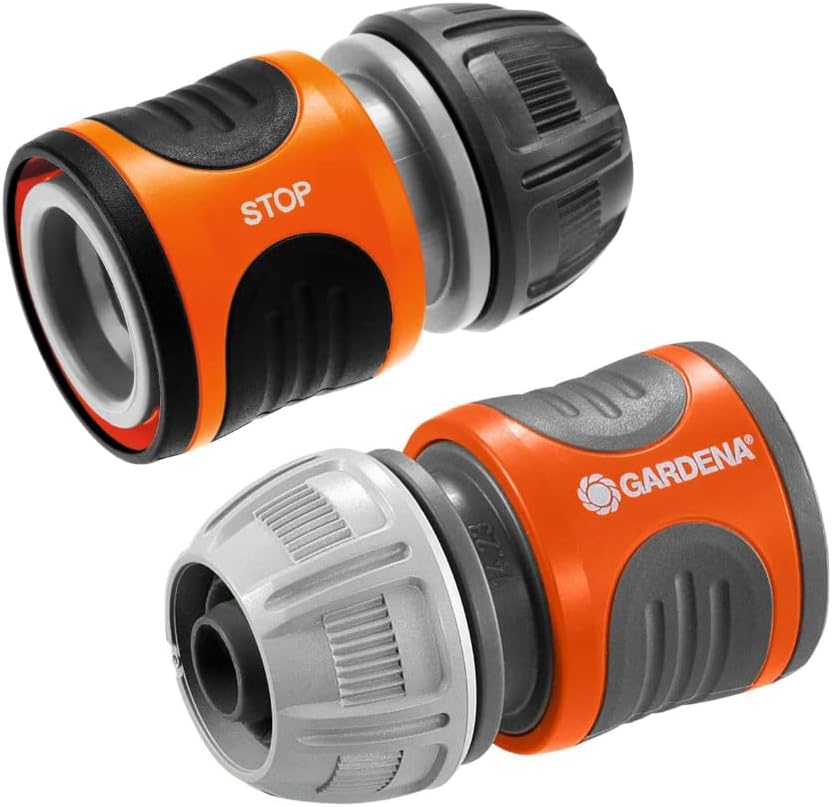 |  | |
 | 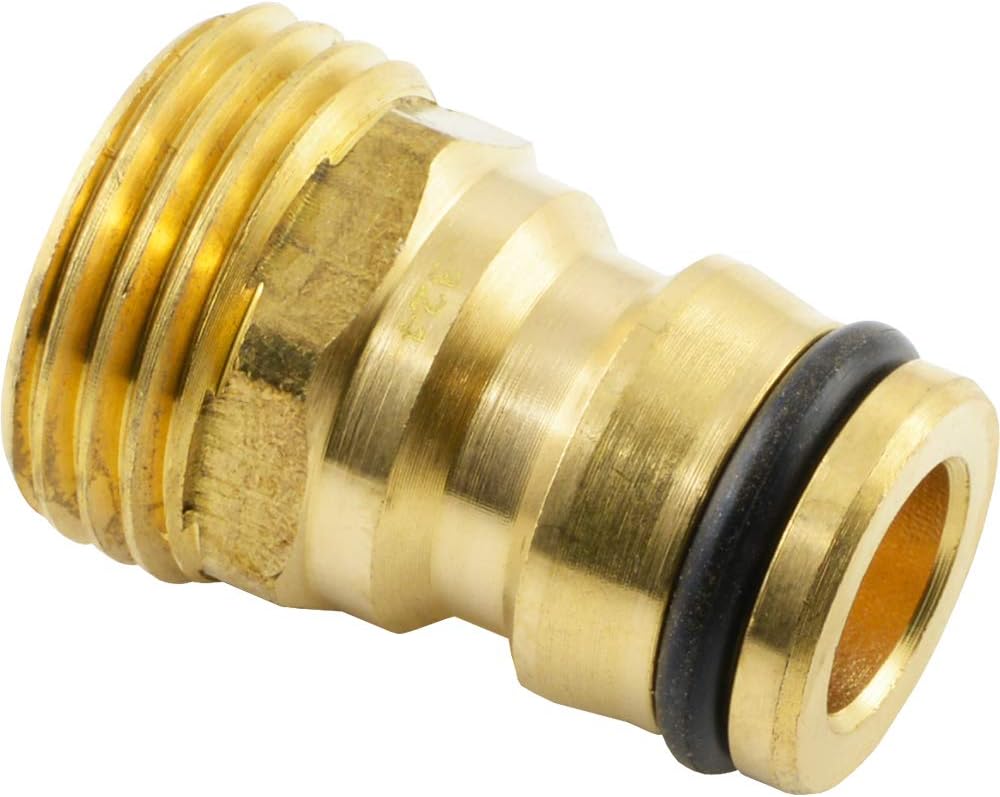 |  |
 |  |
New toy: hand-held depth sounder
In order to measure the depth while using the dinghy, e.g. while finding a passage for Regina Laska or checking the anchorage swing from the dingy, I now have a hand-held depth sounder. Cool, unnecessary and fun!

Automatic Fog-signal and PA-System
During fog, it's a bit tricky to keep track on the fog-signal. The VHF and the fog-horn have now been connected so that it automatically gives the corresponding fog signal. Further, I now have a PA-System, so that I can shout through the hailer. No, not for the crew on foredeck, but possibly to other people close by who don't listen on the VHF?


Spiroll anti-chafing
Spiroll covers for the ropes are primarily intended to be used when avoiding chafing, e.g. against a stone pier. The orange ones are also good to mark a rope, however, e.g. when it is spanning over an adjacent mooring or when lead over the pontoon. Obviously this should be avoided, but when tying up for heavy winds, it can sometimes not be avoided. Switch in the new Lopolight deck-lights shine onto the orange markers at night.

Medical Store now handled by MSOS
After years of dealing with my medical store myself, it has now been outsourced to the leading supplier of medical consultation, stocking and training: MSOS in the UK. A vast majority of superyachts rely on the professionals of MSOS with Dr. Spike Briggs as the owner and CEO. Spike and his crew are also looking after the (Volvo) Ocean Race as well as many round the world rallies such as the Oyster Round the World Rally and countless ordinary cruisers who wish to feel safe and have medical stuff close at hand.
Spike has also been specially invited to Malta to hold a medical course for some of my sailing guests and since then I have also been joining one of his very good STCW Medical courses in held in Southampton, Palma de Mallorca and Fort Lauderdale, FL/USA. It is no surprise that MSOS was awarded runner-up in ACREW’s Best Superyacht Crew Training Award. Congratulations, you deserve it!
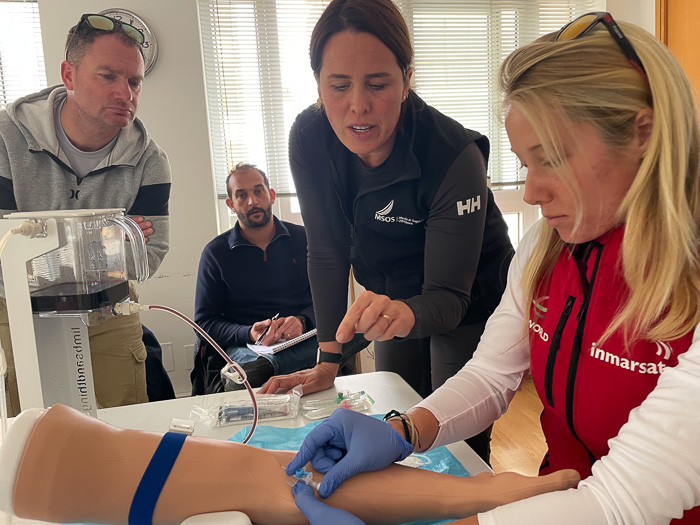
During one of my STCW Medical updates with MSOS in Palma de Mallorca (above and below)

Spike is also the co-author of the 23rd edition of the Ship Captain's Medical Guide that every commercial ship has to have onboard. This book is has been published for over 150 years and was first published in 1868. Spike is further on the committee deciding which medicines ships and yachts need to carry and is therefore one of the men behind the new rule MSN 1905 for commercial vessels, including Regina Laska. Last, but not least, Spike is crazy enough to have raced around the world - sailing "the wrong way" towards east - against the prevailing winds: the BT Global Challenge!
For me, it's an honour to know Spike!
And for the rest of the wonderful crew of MSOS, I can only say: it's such a fantastic feeling that all Medicines are now dealt with by professionals.
Of course, pleasure crafts not crossing oceans don't need as much as Regina Laska carries, and therefore MSOS has a neat little package they call the "Near Ocean Kit". This is what every boat should carry sailing in coastal waters, I think.

Ben Pitman (left) and Spike Briggs (right) at the Lymington Yacht Haven for a relaxed dinner together.

Spike in Malta teaching STCW Proficiency in Medical First Aid to part of the Reginasailing Family

This is all the medicine and medical stuff I through out of the boat when moving to MSOS. It's called "merging systems".

Getting finally everything in order thanks to a fantastic organisation by MSOS.
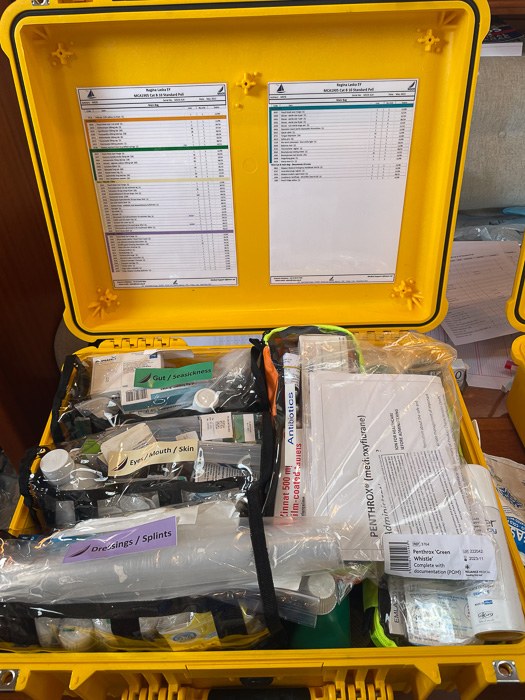
Everything neatly stowed away and easy to find.

Systematically fitting it all into 3 large Peli-Cases plus a couple of more cases.

All perfectly packed including the new Defib in the foreground and the oxygen generator in the blue back in the background.

New MOB Retrieval Device
At boot Düsseldorf I got in contact with a a very nice Austrian Fellow named Hermann Cisar, who had just invented a very promising new MOB retrieval device called POB-NET. I have been rather carefully observant when it comes to various more or less complicated devices to hoist back onboard.
Hoisting horizontally would be a plus, but the issue has always been how to get the casualty into the device, even unconscious, in order to hoist the MOB back on deck. Finally, how and where to stow the system?
Maybe, this is the solution? I will give it a try and test it over summer during my sail training weeks.
It does look rather promising, catching the MOB like a big fish!

Reginasailing Position and Track Data completely redesigned
Our Position and Track Data service has changed its name from Travelmap to now Voyoa. Voyoa has been completely redesigned during last winter and is now ready for beta-testing on Leg 1-2023. It is already looking so much smarter and it's going to be a joy to upload stories, activities and photos to our track!
The track will continue to be transmitted every 10 Minutes via Satellite (Garmin inReach) but new for 2023 is also the Voyoa SmartPhoneTracking App that will allow the positions derived from the smartphone to automatically upload to the Voyoa-chart. Photos taken in your smatphone will also automatically be positioned to the corresponding position where it was taken.
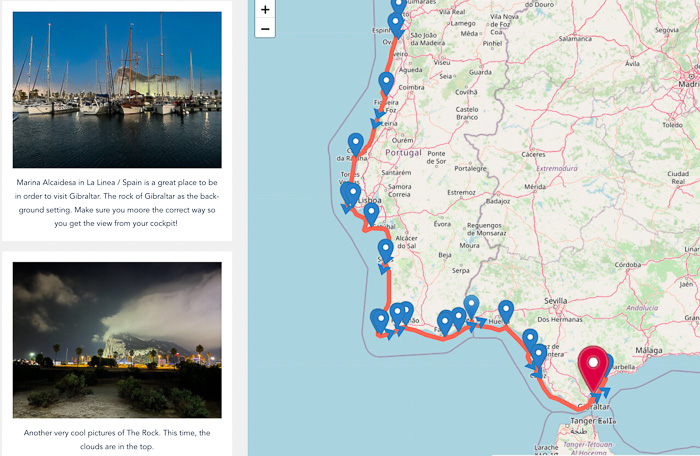
My Voyoa will be available for the public (i.e. anyone), but it is also possible to only allow certain groups to see certain Collections of activity. This allows for private uploading of personal pictures and data, while only certain parts of your family and friends my check out your location and see your photos and activities.
If you are interested to beta-test it, send me an e-mail and I will put you in contact with the developer of this new exciting software.

